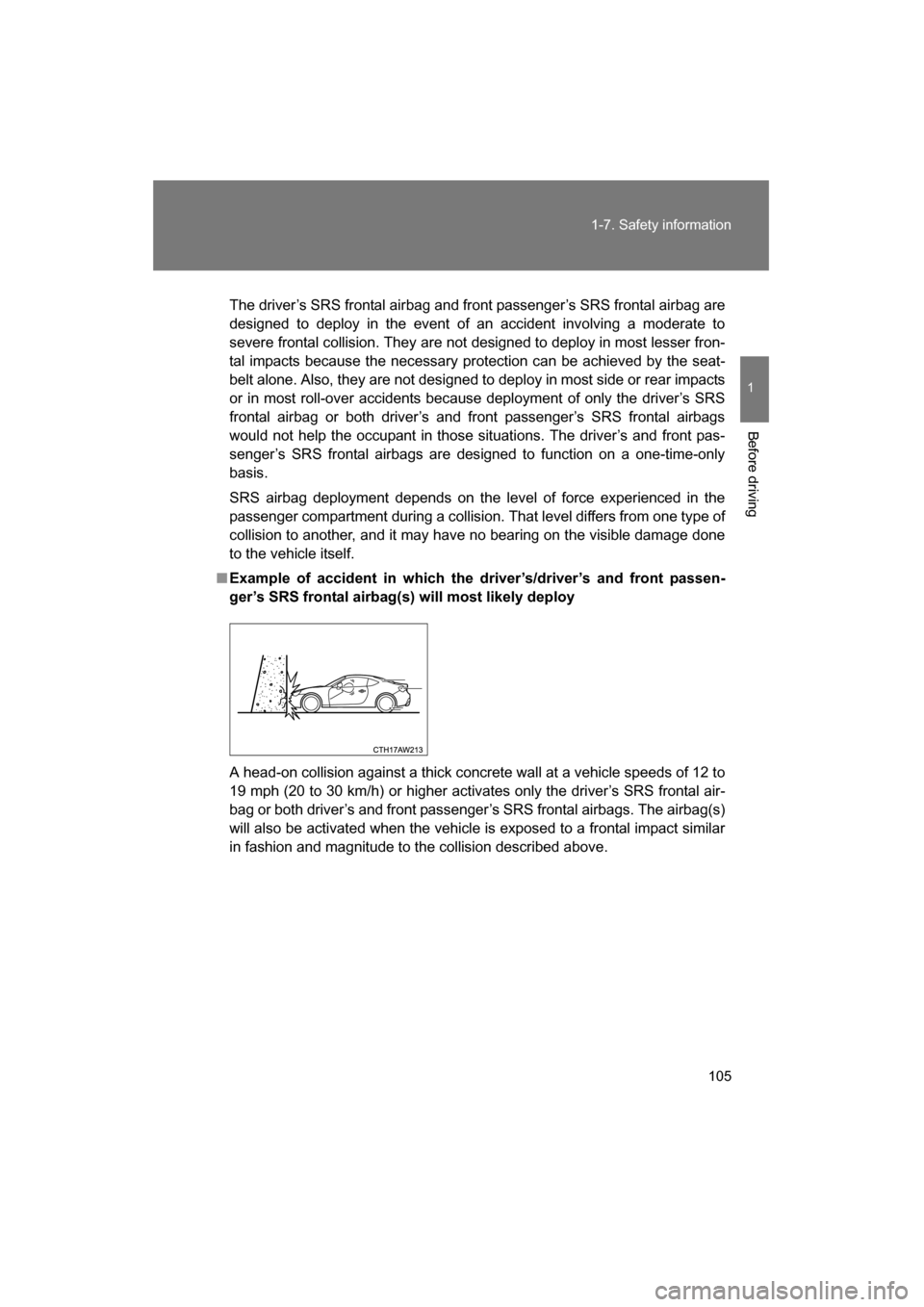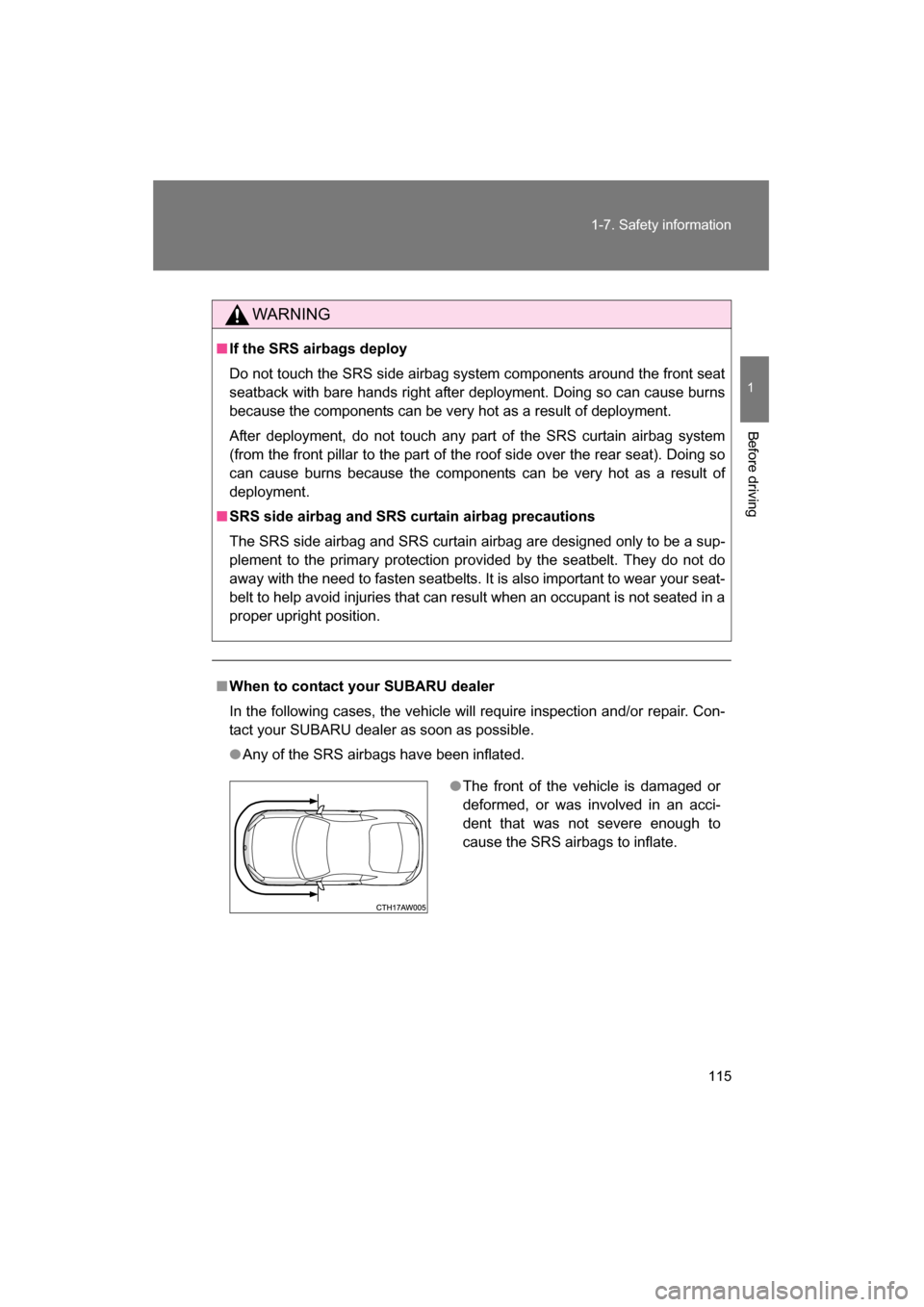Page 104 of 492

104
1-7. Safety information
The SRS airbag can function only when the ignition switch is in the “ON”
position.
The SUBARU advanced frontal airbag system is designed to determine the
activation or deactivation condition of the front passenger’s SRS frontal air-
bag depending on the characteristic of the item(s) or person on the front
passenger’s seat monitored by the front passenger’s occupant detection
system sensor. For this reason, only the driver’s SRS frontal airbag may
deploy in the event of a collision, but this does not mean failure of the sys-tem.
If the front sub sensors and the impact sensors in the airbag control module
detect a predetermined amount of force during a frontal collision, the control
module sends signals to the airbag module(s) (only driver’s module or both
driver’s and front passenger’s modules) instructing the module(s) to inflate
the SRS frontal airbag(s).
The driver’s and front passenger’s SRS frontal airbags use dual stage infla-
tors. The two inflators of each airbag are triggered either sequentially or
simultaneously, depending on the severity of impact, in the case of the
driver’s SRS frontal airbag and depending on the severity of impact and the
characteristic of the item(s) or person on the seat in the case of the front
passenger’s SRS frontal airbag.
After deployment, the SRS airbag immediately starts to deflate so that the
driver’s vision is not obstructed. The time required from detecting impact to
the deflation of the SRS airbag after deployment is shorter than the blink of
an eye.
Both when only the driver’s SRS frontal airbag deploys and the driver’s and
front passenger’s SRS frontal airbags deploy, the driver’s and front passen-
ger’s seatbelt pretensioners operate at the same time.
Although it is highly unlikely that the SRS airbag would activate in a non-
accident situation, should it occur, the SRS airbag will deflate quickly, not
obscuring vision and will not interfere with the driver's ability to maintain con-
trol of the vehicle.
When the SRS airbag deploys, a sudden, fairly loud inflation noise will be
heard and some smoke will be released. These occurrences are a normal
result of the deployment. This smoke does not indicate a fire in the vehicle.
Page 105 of 492

105
1-7. Safety information
1
Before driving
The driver’s SRS frontal airbag and front passenger’s SRS frontal airbag are
designed to deploy in the event of an accident involving a moderate to
severe frontal collision. They are not designed to deploy in most lesser fron-
tal impacts because the necessary protection can be achieved by the seat-
belt alone. Also, they are not designed to deploy in most side or rear impacts
or in most roll-over accidents because deployment of only the driver’s SRS
frontal airbag or both driver’s and front passenger’s SRS frontal airbags
would not help the occupant in those situations. The driver’s and front pas-
senger’s SRS frontal airbags are designed to function on a one-time-only
basis.
SRS airbag deployment depends on the level of force experienced in the
passenger compartment during a collision. That level differs from one type of
collision to another, and it may have no bearing on the visible damage done
to the vehicle itself.
■Example of accident in which the driver’s/driver’s and front passen-
ger’s SRS frontal airbag(s) will most likely deploy
A head-on collision against a thick concrete wall at a vehicle speeds of 12 to
19 mph (20 to 30 km/h) or higher activates only the driver’s SRS frontal air-
bag or both driver’s and front passenger ’s SRS frontal airbags. The airbag(s)
will also be activated when the vehicle is exposed to a frontal impact similar
in fashion and magnitude to the collision described above.
Page 110 of 492
110
1-7. Safety information
SRS side airbag and SRS curtain airbagThe SRS side airbag is stored in the door side of each front seat
seatback, which bears an “SRS AIRBAG” label.
In a moderate to severe side impact collision, the SRS side airbag on
the impacted side of the vehicle deploys between the occupant and
the door panel and supplements the seatbelt by reducing the impact
on the occupant’s chest and waist. The SRS side airbag operates
only for front seat occupants.
The SRS curtain airbag on each side of the cabin is stored in the roof
side (between the front pillar and a point over the rear seat). An “SRS
AIRBAG” mark is located at the top of each front and rear pillar.
In a moderate to severe side impact collision, the SRS curtain airbag
on the impacted side of the vehicle deploys between the occupant
and the side window and supplements the seatbelt by reducing the
impact on the occupant’s head.
Page 115 of 492

115
1-7. Safety information
1
Before driving
WARNING
■If the SRS airbags deploy
Do not touch the SRS side airbag system components around the front seat
seatback with bare hands right after deployment. Doing so can cause burns
because the components can be very hot as a result of deployment.
After deployment, do not touch any part of the SRS curtain airbag system
(from the front pillar to the part of the roof side over the rear seat). Doing so
can cause burns because the components can be very hot as a result of
deployment.
■SRS side airbag and SRS curtain airbag precautions
The SRS side airbag and SRS curtain airbag are designed only to be a sup-
plement to the primary protection provided by the seatbelt. They do not do
away with the need to fasten seatbelts. It is also important to wear your seat-
belt to help avoid injuries that can result when an occupant is not seated in a
proper upright position.
■When to contact your SUBARU dealer
In the following cases, the vehicle will require inspection and/or repair. Con-
tact your SUBARU dealer as soon as possible.
●Any of the SRS airbags have been inflated.
●The front of the vehicle is damaged or
deformed, or was involved in an acci-
dent that was not severe enough to
cause the SRS airbags to inflate.
Page 117 of 492
117
1-7. Safety information
1
Before driving
WARNING
■SRS airbag precautions
Observe the following precautions regarding the SRS airbags.
Failure to do so may cause death or serious injury.
●The driver and all passengers in the vehicle must wear their seatbelts
properly.
The SRS airbags are supplemental devices to be used with the seatbelts.
●The driver should always sit upright and well back in the seat as far from
the steering wheel as practical while still maintaining full vehicle control
and the front passenger should move the seat as far back as possible and
sit upright and well back in the seat.
Page 118 of 492

118
1-7. Safety information
WARNING
■SRS airbag precautions
●The SRS front passenger airbag also deploys with considerable force, and
can cause death or serious injury especially if the front passenger is very
close to the airbag. The front passenger seat should be as far from the air-
bag as possible with the seatback adjusted, so the front passenger sitsupright.
●Improperly seated and/or restrained infants and children can be killed or
seriously injured by a deploying airbag. An infant or child who is too small
to use a seatbelt should be properly secured using a child restraint sys-
tem. SUBARU strongly recommends that all infants and children be placed
in the rear seats of the vehicle and properly restrained. The rear seats are
safer for infants and children than the front passenger seat. ( →P. 133)
●Do not sit on the edge of the seat or
lean against the dashboard.
●Do not allow a child to stand in front of
the SRS front passenger airbag unit or
sit on the knees of a front passenger.
●Do not allow the front seat occupants to
hold items on their knees.
●Do not lean against the door, the roof
side rail or the front, side and rear pil-
lars.
Page 121 of 492

121
1-7. Safety information
1
Before driving
SRS airbag system monitorsA diagnostic system continually
monitors the readiness of the
SRS airbag system (including
front seatbelt pretensioners)
while the vehicle is being driven.
The SRS airbag system warning
light will show normal system
operation by illuminating for
approximately 6 seconds when
the ignition switch is turned to
the “ON” position.
The following components are monitored by the indicator: ● Front sub sensor (right-hand side)
● Front sub sensor (left-hand side)
● Airbag control module (including impact sensors)
● Frontal airbag module (driver’s side)
● Frontal airbag module (front passenger’s side)
● Side airbag sensor (center pillar right-hand side)
● Side airbag sensor (center pillar left-hand side)
● Door impact sensor (right-hand side)
● Door impact sensor (left-hand side)
● Side airbag module (driver’s side)
● Side airbag module (front passenger’s side)
● Curtain airbag sensor (rear wheel house right-hand side)
● Curtain airbag sensor (rear wheel house left-hand side)
● Curtain airbag module (right-hand side)
Page 122 of 492

122
1-7. Safety information
●Curtain airbag module (left-hand side)
● Satellite safing sensor (under the center of the rear seats)
● Seatbelt pretensioner (driver’s side)
● Seatbelt pretensioner (front passenger’s side)
● Seatbelt buckle switch (front passenger’s side)
● Front passenger’s occupant detection system sensor
● Front passenger’s occupant detection control module
● Front passenger’s frontal airbag ON and OFF indicator
● All related wiring
WARNING
■SRS warning light
If the warning light exhibits any of the following conditions, there may be a
malfunction in the seatbelt pretensioners and/or SRS airbag system. Imme-
diately take your vehicle to your nearest SUBARU dealer to have the system
checked. Unless checked and properly repaired, the seatbelt pretensioners
and/or SRS airbag will not operate properly in the event of a collision, which
may increase the risk of injury.
●Flashing or flickering of the warning light
●No illumination of the warning light when the ignition switch is first turned
to the “ON” position.
●Continuous illumination of the warning light
●Illumination of the warning light while driving